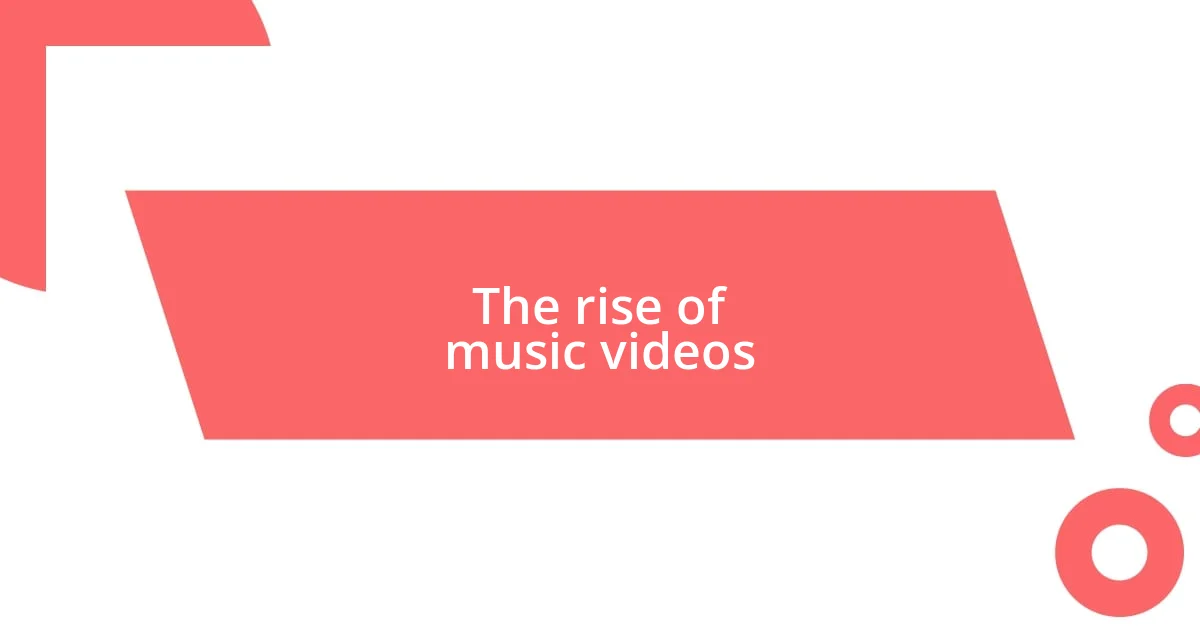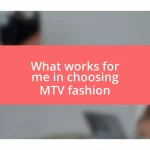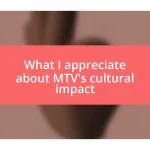Key takeaways:
- MTV transformed music videos into a cultural platform, empowering youth to express individuality and defy societal norms.
- Iconic performances, like Madonna’s and Kurt Cobain’s, symbolized rebellion, fostering a sense of community and encouraging open conversations about identity and societal issues.
- Fashion trends influenced by MTV provided a means for self-expression, reflecting teenage rebellion and individuality through bold attire and styles.

MTV’s influence on youth culture
MTV was this vibrant pulse in the ’80s and ’90s that turned music videos into a cultural phenomenon. I can vividly recall rushing home from school, eager to catch “Total Request Live” and see which videos were winning the hearts of teenagers. It made me feel connected to this larger movement, as if we were all part of a grand rebellion against what was considered mainstream.
What struck me most was how MTV boldly showcased diverse narratives, pushing boundaries that weren’t reflected in traditional media. I remember feeling empowered by artists like Madonna, who challenged societal norms and encouraged us to embrace our individuality. It sparked a question in my mind: how could music not just entertain but also inspire us to express ourselves authentically?
Looking back, I see MTV as the soundtrack of my teenage angst, a channel that defined tastes, fashions, and attitudes. Who could forget those iconic fashion statements and outrageous hairstyles that actually encouraged us to stand out? It was almost like a rite of passage, shaping our identities while providing the soundtrack to our youthful rebellion. The emotional connection we shared with those videos was palpable, as if they were speaking directly to our dreams and struggles.

The rise of music videos
The explosion of music videos in the early ’80s marked a pivotal moment in pop culture, transcending the traditional boundaries of music to create a visual storytelling platform. I still remember my excitement when the opening notes of a new video hit my TV screen, drawing me into a world that felt both glamorous and rebellious. It was like stepping into an alternate reality where broader themes—love, heartbreak, freedom—were vividly portrayed and accompanied by stunning visuals.
As music videos emerged, they became a crucial avenue for artists to express their identity and connect with their audience. I can recall the sheer thrill of watching detailed narratives unfold, like in Michael Jackson’s “Thriller.” The video wasn’t just a song played visually; it felt like a mini-movie that invited us to explore emotions and stories far beyond the catchy beat. These videos had a way of resonating with my inner teenager, making me feel like I wasn’t alone in my struggles and dreams.
In a landscape where youth culture often felt limited, music videos turned into anthems of defiance and self-expression. Every time I saw a band like Nirvana, I’d resonate with their raw energy and authenticity. Their videos encouraged me to question norms, embrace my uniqueness, and realize that it was okay to be different. MTV wasn’t merely broadcasting; it was a catalyst for change, allowing us to reflect our rebellious spirits through our chosen music and style.
| Characteristics | Impact of Music Videos |
|---|---|
| Visual Storytelling | Engaged audiences in a narrative beyond sound |
| Representation of Identity | Provided a platform for artists to showcase diverse backgrounds |
| Connection to Culture | Helped teenagers feel part of a larger movement |
| Empowerment | Encouraged self-expression and authenticity among youth |

Iconic MTV moments of defiance
I can remember watching the unforgettable moment when Madonna stormed the MTV stage during the first Video Music Awards in 1984, draped in lace and attitude. Her performance of “Like a Virgin” was more than just a song; it was an anthem of defiance. It felt revolutionary to see a woman unashamedly express her sexuality, igniting conversations that many weren’t ready to have. In that moment, I was inspired—could we truly redefine ourselves against the rigid expectations set before us?
There were countless moments that sparked rebellion and a sense of identity. Here are a few that stand out to me:
-
Kurt Cobain’s “Smells Like Teen Spirit” Performance: An eruption of raw energy that made it clear it was okay to not fit in.
-
Britney Spears’ 2007 VMA Performance: A powerful reminder of vulnerability behind the glitz, challenging perceptions of fame and mental health.
-
Rage Against the Machine’s Protest at the VMAs: A bold stand against censorship, showcasing how music can be a vehicle for political rebellion.
-
Lady Gaga’s “Born This Way” Debut: A beautiful celebration of individuality and acceptance, which spoke directly to misfits everywhere.
-
Madonna’s 1990 VMAs Performance with a Same-Sex Kiss: A provocative moment that prompted discussions on sexuality and acceptance, forever changing the landscape of public discourse.
Each of these iconic moments resonated deeply with me, reinforcing the idea that MTV wasn’t just a TV channel; it was a revolutionary force that embraced defiance and fostered a sense of community among those of us yearning for change.

Connecting rebellion to music choices
When I think about how music choices spoke to my rebellious spirit, I can clearly recall the first time I heard Rage Against the Machine’s “Killing in the Name.” That song ignited a fire in me; the raw power of its message felt like a rallying cry for anyone angered by the injustices surrounding us. I remember blasting that track in my room, feeling empowered and part of something bigger, as if every lyric was a punch to the status quo.
As I discovered different genres, my playlists mirrored my desire to challenge societal norms. I was drawn to the angst in grunge music, where bands like Pearl Jam and Alice in Chains articulated feelings of confusion and despair. Their music became my soundtrack of rebellion. I often pondered—how could I express my individuality in a world that seemed determined to box me in? These artists gave voice to my frustrations, showing me that it was not only acceptable but necessary to question authority.
There’s something deeply personal about how we connect rebellion to our music choices. Each new album I explored felt like unlocking another door to freedom. Songs by artists like Fiona Apple and The Smashing Pumpkins resonated not just with my teenage angst but with my yearning for authenticity. In those moments, I felt seen and understood, as if the music was validating my struggle to carve out my identity. What could be more liberating than that?

How fashion reflected MTV’s impact
Fashion was a key way MTV influenced our teenage rebellion. I can still remember the excitement I felt flipping through my wardrobe inspired by the bold looks of artists. The oversized flannels and ripped jeans from the grunge scene, paired with chunky combat boots, made me feel like I could step into that world and challenge the status quo. It wasn’t just clothing; it was an armor that let me express my defiance toward conventional norms.
Artists like Madonna and Cyndi Lauper didn’t just perform—they transformed the way we saw individuality. I vividly recall replicating Lauper’s eclectic style with bright colors, mismatched accessories, and that daring attitude. It was liberating! I wanted to stand out, and each outfit I threw together felt like a statement. I often asked myself: “Why should I conform when I can create my own identity?” Through fashion, I found a way to communicate my beliefs, embracing the notion that self-expression could defy expectations.
Looking back, those fashion choices held more meaning than mere visuals; they told a story of rebellion and self-discovery. I loved how fashion on MTV was ever-evolving, mirroring the trends and attitudes of each era. I’ll never forget showing up to school in a graphic tee emblazoned with a rebellious slogan, feeling like I was part of a movement. Music and fashion intertwined beautifully—it wasn’t just about what we wore, but what we said about who we were. Fashion, for me, felt like a personal revolution that mirrored the spirit of MTV itself.














